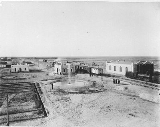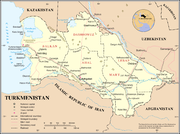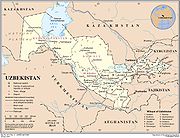
Trans-Caspian railway
Encyclopedia

Silk Road
The Silk Road or Silk Route refers to a historical network of interlinking trade routes across the Afro-Eurasian landmass that connected East, South, and Western Asia with the Mediterranean and European world, as well as parts of North and East Africa...
through much of western Central Asia
Central Asia
Central Asia is a core region of the Asian continent from the Caspian Sea in the west, China in the east, Afghanistan in the south, and Russia in the north...
. It was built by the Russian Empire
Russian Empire
The Russian Empire was a state that existed from 1721 until the Russian Revolution of 1917. It was the successor to the Tsardom of Russia and the predecessor of the Soviet Union...
during its expansion into Central Asia in the 19th century. The railway was started in 1879, following the Russian defeat of Khokand. Originally it served a military purpose of facilitating the Imperial Russian Army
Imperial Russian Army
The Imperial Russian Army was the land armed force of the Russian Empire, active from around 1721 to the Russian Revolution of 1917. In the early 1850s, the Russian army consisted of around 938,731 regular soldiers and 245,850 irregulars . Until the time of military reform of Dmitry Milyutin in...
in actions against the local resistance to their rule. However when Lord Curzon visited the railway, he remarked that he considered its significance went beyond local military control and threatened British
British Empire
The British Empire comprised the dominions, colonies, protectorates, mandates and other territories ruled or administered by the United Kingdom. It originated with the overseas colonies and trading posts established by England in the late 16th and early 17th centuries. At its height, it was the...
interests in Asia
Asia
Asia is the world's largest and most populous continent, located primarily in the eastern and northern hemispheres. It covers 8.7% of the Earth's total surface area and with approximately 3.879 billion people, it hosts 60% of the world's current human population...
.
Construction


Russian Empire
The Russian Empire was a state that existed from 1721 until the Russian Revolution of 1917. It was the successor to the Tsardom of Russia and the predecessor of the Soviet Union...
conquest of Transcaspia
Transcaspian Region
Transcaspian Region , or Transcaspia, was the name used from the second half of the 19th century until 1924 for the section of Russian Empire to the east of the Caspian Sea, bounded to the south by Iran's Khorasan Province and Afghanistan, to the north by the former Russian province of Uralsk, and...
under General Mikhail Skobelev
Mikhail Skobelev
Mikhail Dmitrievich Skobelev was a Russian general famous for his conquest of Central Asia and heroism during the Russo-Turkish War of 1877-78. Dressed in white uniform and mounted on a white horse, and always in the thickest of the fray, he was known and adored by his soldiers as the "White...
. It was rapidly altered to the standard Russian gauge of five feet, and construction through to Ashkabad and Merv (modern Mary
Mary, Turkmenistan
Mary is the capital city of Mary Province in Turkmenistan. Former names include Merv, Meru and Margiana. It is located at . The city is an oasis in the Karakum Desert, located on the Murghab river. In 2009, Mary had a population of 123,000 , up from 92,000 in the 1989 census.-History:The ancient...
) was completed under General Michael Nicolaivitch Annenkoff in 1886. Originally the line began from Uzun-Ada on the Caspian Sea
Caspian Sea
The Caspian Sea is the largest enclosed body of water on Earth by area, variously classed as the world's largest lake or a full-fledged sea. The sea has a surface area of and a volume of...
, but the terminus was later shifted north to the harbour at Krasnovodsk. The Railway reached Samarkand
Samarkand
Although a Persian-speaking region, it was not united politically with Iran most of the times between the disintegration of the Seleucid Empire and the Arab conquest . In the 6th century it was within the domain of the Turkic kingdom of the Göktürks.At the start of the 8th century Samarkand came...
via Bukhara
Bukhara
Bukhara , from the Soghdian βuxārak , is the capital of the Bukhara Province of Uzbekistan. The nation's fifth-largest city, it has a population of 263,400 . The region around Bukhara has been inhabited for at least five millennia, and the city has existed for half that time...
in 1888, where it halted for ten years until extended to Tashkent
Tashkent
Tashkent is the capital of Uzbekistan and of the Tashkent Province. The officially registered population of the city in 2008 was about 2.2 million. Unofficial sources estimate the actual population may be as much as 4.45 million.-Early Islamic History:...
and Andijan
Andijan
Andijan or Andizhan is the fourth-largest city in Uzbekistan, and the capital of the Andijan Province. It is located in the east of the country, at , in the Fergana Valley, near the border with Kyrgyzstan on the Andijan-Say River...
in 1898. The permanent bridge over the Oxus (Amu-Darya) was not completed until 1901, and until then trains ran over a rickety wooden construction that was often damaged by floods. As early as 1905, there was a train ferry
Train ferry
A train ferry is a ship designed to carry railway vehicles. Typically, one level of the ship is fitted with railway tracks, and the vessel has a door at the front and/or rear to give access to the wharves. In the United States, train ferries are sometimes referred to as "car ferries", as...
across the Caspian Sea
Caspian Sea
The Caspian Sea is the largest enclosed body of water on Earth by area, variously classed as the world's largest lake or a full-fledged sea. The sea has a surface area of and a volume of...
from Krasnovodsk to Baku
Baku
Baku , sometimes spelled as Baki or Bakou, is the capital and largest city of Azerbaijan, as well as the largest city on the Caspian Sea and of the Caucasus region. It is located on the southern shore of the Absheron Peninsula, which projects into the Caspian Sea. The city consists of two principal...
in Azerbaijan
Azerbaijan
Azerbaijan , officially the Republic of Azerbaijan is the largest country in the Caucasus region of Eurasia. Located at the crossroads of Western Asia and Eastern Europe, it is bounded by the Caspian Sea to the east, Russia to the north, Georgia to the northwest, Armenia to the west, and Iran to...
. The Tashkent Railway connecting the Transcaspian Military Railway with the network of other Russian and European railways was completed in 1906.
Economic Impact
The railway permitted a massive increase in the amount of cotton exported from the region. This increased from 873,092 pudy in 1888 to 3,588,025 in 1893. Also sugar, keroseneKerosene
Kerosene, sometimes spelled kerosine in scientific and industrial usage, also known as paraffin or paraffin oil in the United Kingdom, Hong Kong, Ireland and South Africa, is a combustible hydrocarbon liquid. The name is derived from Greek keros...
, wood, iron and construction material were imported into the area. These rising trade figures were used by Governor-General Nikolai Rozenbakh
Nikolai Rozenbakh
Nikolai Ottonovich fon Rozenbakh was Russian General during the nineteenth century.He was Governor-General of the Guberniya of Russian Turkestan from 1884-1889....
to argue for the extension to Tashkent, while the merchant N. I. Reshetnikov offered private funds for the same purpose.
Revolution and Civil War
The railway, as the most important means of communication in the area, and the workers on the railway became key activists during the Russian revolution. It was thirty five railway workers who founded the Tashkent SovietTashkent Soviet
The Tashkent Soviet was a public organisation set up in Tashkent during the Russian Revolution.The Tashkent Soviet was established on 2 March 1917 at an inaugural meeting which consisted of thirty five workers from the Central Asian Railway. It was headed by a technician by the name of I. I. Bel'kov...
on 2 March 1917. However railway workers along the western end of the railway were also involved in breaking away from the Bolshevik
Bolshevik
The Bolsheviks, originally also Bolshevists , derived from bol'shinstvo, "majority") were a faction of the Marxist Russian Social Democratic Labour Party which split apart from the Menshevik faction at the Second Party Congress in 1903....
oriented Tashkent Soviet, setting up the Ashkhabad Executive Committee
Transcaspian Government
The Transcaspian Government was set up by Railway workers of the Trans-Caspian Railway in 1918 and lasted until July 1919. It was based at Ashgabat.-Origin:...
on 14th July 1918.
Both railway and workers also played an important role in the Russian Civil War
Russian Civil War
The Russian Civil War was a multi-party war that occurred within the former Russian Empire after the Russian provisional government collapsed to the Soviets, under the domination of the Bolshevik party. Soviet forces first assumed power in Petrograd The Russian Civil War (1917–1923) was a...
. Troops of the British Indian Army
British Indian Army
The British Indian Army, officially simply the Indian Army, was the principal army of the British Raj in India before the partition of India in 1947...
participated in some of the battles along the railway line. Tashkent
Tashkent
Tashkent is the capital of Uzbekistan and of the Tashkent Province. The officially registered population of the city in 2008 was about 2.2 million. Unofficial sources estimate the actual population may be as much as 4.45 million.-Early Islamic History:...
was an important bastion for the Red Army
Red Army
The Workers' and Peasants' Red Army started out as the Soviet Union's revolutionary communist combat groups during the Russian Civil War of 1918-1922. It grew into the national army of the Soviet Union. By the 1930s the Red Army was among the largest armies in history.The "Red Army" name refers to...
.
Under the Soviet Union
During the Soviet period and beyond, the road was administrated from TashkentTashkent
Tashkent is the capital of Uzbekistan and of the Tashkent Province. The officially registered population of the city in 2008 was about 2.2 million. Unofficial sources estimate the actual population may be as much as 4.45 million.-Early Islamic History:...
.
Route
The railway starts at the eastern shore of the Caspian Sea at Turkmenbashi (Krasnovodsk) and heads southeast, along the edge of the Karakum DesertKarakum Desert
The Karakum Desert, also spelled Kara-Kum and Gara Gum is a desert in Central Asia. It occupies about 70 percent, or 350,000 km², of the area of Turkmenistan....
. For a while it runs parallel to the Qaraqum Canal
Qaraqum Canal
The Qaraqum Canal in Turkmenistan is one of the largest irrigation and water supply canals in the world...
. It passes through Ashgabat (Ashkhabad) and continues southeast, hugging the foothills of the Kopet Dagh mountains, and passing through Tedzhen. At Tedzhen, a modern railway link branches off, heading to the Iran
Iran
Iran , officially the Islamic Republic of Iran , is a country in Southern and Western Asia. The name "Iran" has been in use natively since the Sassanian era and came into use internationally in 1935, before which the country was known to the Western world as Persia...
ian border at Serakhs, and thence to Mashhad
Mashhad
Mashhad , is the second largest city in Iran and one of the holiest cities in the Shia Muslim world. It is also the only major Iranian city with an Arabic name. It is located east of Tehran, at the center of the Razavi Khorasan Province close to the borders of Afghanistan and Turkmenistan. Its...
in Iran
Iran
Iran , officially the Islamic Republic of Iran , is a country in Southern and Western Asia. The name "Iran" has been in use natively since the Sassanian era and came into use internationally in 1935, before which the country was known to the Western world as Persia...
. From Tedzhen, the Trans-Caspian heads northeast, through Mary
Mary, Turkmenistan
Mary is the capital city of Mary Province in Turkmenistan. Former names include Merv, Meru and Margiana. It is located at . The city is an oasis in the Karakum Desert, located on the Murghab river. In 2009, Mary had a population of 123,000 , up from 92,000 in the 1989 census.-History:The ancient...
(Merv
Merv
Merv , formerly Achaemenid Satrapy of Margiana, and later Alexandria and Antiochia in Margiana , was a major oasis-city in Central Asia, on the historical Silk Road, located near today's Mary in Turkmenistan. Several cities have existed on this site, which is significant for the interchange of...
), where a branch line built in the 1890s leads to the Afghan
Afghanistan
Afghanistan , officially the Islamic Republic of Afghanistan, is a landlocked country located in the centre of Asia, forming South Asia, Central Asia and the Middle East. With a population of about 29 million, it has an area of , making it the 42nd most populous and 41st largest nation in the world...
border at Gushgy, and the main line carries on to Turkmenabat
Türkmenabat
Türkmenabat , formerly and since the medieval times, Chardzhou , also spelled Çärjew, Chardjui, Charjou, Chardzhev, Charjev, Chärjew, or Charjew , ancient Amul, is a town in Turkmenistan, capital of Lebap Province...
(Chärjew). From there a branch built in the Soviet period connects northwestward to Urganch and on to Kazakhstan
Kazakhstan
Kazakhstan , officially the Republic of Kazakhstan, is a transcontinental country in Central Asia and Eastern Europe. Ranked as the ninth largest country in the world, it is also the world's largest landlocked country; its territory of is greater than Western Europe...
and Russia.
The main line continues from Turkmenabat through Bukhoro (where a branch line built in 1910 leads to Termez
Termez
Termez is a city in southern Uzbekistan near the border with Afghanistan.Some link the name of the city to thermos, "hot" in Greek, tracing its name back to Alexander the Great. Others suggest that it came from Sanskrit taramato, meaning "on the river bank". It is the hottest point of Uzbekistan...
and Dushanbe
Dushanbe
-Economy:Coal, lead, and arsenic are mined nearby in the cities of Nurek and Kulob allowing for the industrialization of Dushanbe. The Nurek Dam, the world's highest as of 2008, generates 95% of Tajikistan's electricity, and another dam, the Roghun Dam, is planned on the Vakhsh River...
) and then carries on to Samarqand. At Sirdaryo
Sirdaryo
Sirdaryo also spelled as Syrdarya is a city in Uzbekistan....
, where it crosses the Syr Darya
Syr Darya
The Syr Darya , also transliterated Syrdarya or Sirdaryo, is a river in Central Asia, sometimes known as the Jaxartes or Yaxartes from its Ancient Greek name . The Greek name is derived from Old Persian, Yakhsha Arta , a reference to the color of the river's water...
river, a branch runs east into the fertile Fergana Valley
Fergana Valley
The Fergana Valley or Farghana Valley is a region in Central Asia spreading across eastern Uzbekistan, Kyrgyzstan and Tajikistan. Divided across three subdivisions of the former Soviet Union, the valley is ethnically diverse, and in the early 21st century was the scene of ethnic conflict...
. From there the railway continues to Tashkent
Tashkent
Tashkent is the capital of Uzbekistan and of the Tashkent Province. The officially registered population of the city in 2008 was about 2.2 million. Unofficial sources estimate the actual population may be as much as 4.45 million.-Early Islamic History:...
. There another northwest bound line
Trans-Aral Railway
The broad gauge Trans-Aral Railway was built in 1906 connecting Orenburg and Tashkent, then both in the Russian Empire. For the first part of the 20th century it was the only railway-connection between European Russia and Central Asia.There were plans to construct the Orenburg-Tashkent line as...
runs to Kazakhstan, which branches at Arys
Arys, Kazakhstan
Arys , is a town in South Kazakhstan Province of Kazakhstan. The population of the city was reported in 2007 as 37.6 thousand; together with the district administratively subordinated to the city's government, it was 64.7 thousand....
forming the Turkestan-Siberia Railway
Turkestan-Siberia Railway
The Turkestan–Siberian Railway is a broad gauge railway that connects Central Asia with Siberia. It starts north of Tashkent in Uzbekistan at Arys, where it branches off from the Trans-Caspian Railway. It heads roughly northeast through Shymkent, Taraz, Bishkek to the former Kazakh capital of...
to Novosibirsk
Novosibirsk
Novosibirsk is the third-largest city in Russia, after Moscow and Saint Petersburg, and the largest city of Siberia, with a population of 1,473,737 . It is the administrative center of Novosibirsk Oblast as well as of the Siberian Federal District...
.

